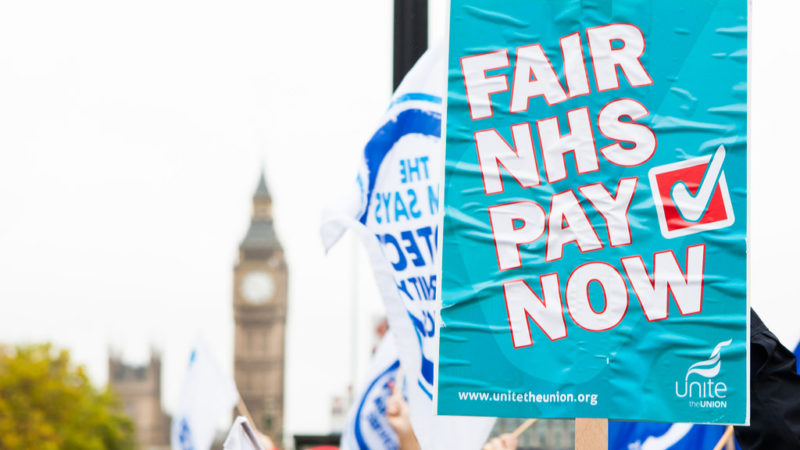Void of trade union cooperation, and with the Covid exit-wave making industrial action difficult, a 3% pay rise may well be as good as it gets, writes Alex Maguire.

Alex Maguire was a trade union shop steward and is now a union official.
After a farcical process on Tuesday afternoon, the government has finally announced that NHS staff will receive a 3% pay rise. Unlike the 2018 deal on NHS pay – and the 4% recently given in Scotland – this one has been imposed by pay review body and therefore is not one that trade unions can vote to accept or reject.
Most NHS trade unions and professional bodies have condemned this increase. It will however be difficult for them to change the government’s mind.
Different trade union interests
This is partly because of the lack of a unified front from trade unions during the pay review process. All the trade unions and professional bodies in the NHS represent different interests. For example, the Royal College of Nurses (RCN) is a closed union in that it only lets nurses and healthcare assistants join it, therefore it represents the interests of these workers above all others.
On the other hand, Union – the public service union – is open to anyone employed in the public sector, and most of its members in the NHS are drawn from between Band One and Band Five on the Agenda for Change payscale.
Other unions such as GMB and Unite, do not have as many members in the NHS, and they tend to be concentrated in certain areas. Most of GMB’s NHS members, for instance, are drawn from the ambulance service.
Consequently, the different unions involved in the NHS have pushed for different deals that would most benefit their members and/or their longer-term interests.
15% pay rise unattainable
For instance, GMB and Unite will have known that the 15% – the highest of all the pay claims – they are calling for is unattainable, but it benefits them to be seen to be campaigning for it, particularly for recruiting members from other unions (GMB have recently tried to off-set their falling membership by retreating from the private sector and into the public sector).
Unison and the RCN, as the two largest unions in the NHS, have more skin in the game, though the RCN’s insistence on 12.5% is surprising, even if, in their submitted evidence to the pay review body, they did provide a fully costed way that the government could provide it.
Of all the proposals, Unision’s £2,000 uplift to every NHS worker on Agenda for Change, or at least a downwardly negotiated variant, was probably the best attainable deal. However, this deal would have needed every union pushing for it, which was always unlikely to happen. The RCN cannot really push for a deal that would see a porter’s salary rise by a substantially greater proportion than a nurse, and therefore erode workplace differentials.
This is the nature of the NHS, multiple professions/occupations are organised alongside each other on the shopfloor and they all have their own rights and interests.
3% is in the ‘sweet spot’
Aside from the issue of trade union cooperation, further complicating securing a rise greater than the government’s is that 3% is in the sweet spot, both in terms of staff striking and public support for the strike. Multiple NHS trade unions have commissioned surveys of the public and they all show support for a pay rise between roughly 3 and 5%. Any higher than this and public support rapidly fades while staff willingness to strike also significantly decreases. Equally, the current Covid exit-wave makes it harder for staff to partake in industrial action, as all NHS industrial action is beset by questions of patient safety.
What happens next?
Do the RCN, emboldened by their success in Northern Ireland from December 2019-January 2020, back up their threat of industrial action? Of all the trade unions/professional bodies they have seemed the most militant and probably have the most resources to support industrial action (they have created an industrial action fund of £35,000,000).
The only way to shift the government’s position would be the industrial action/the real threat of industrial action. However, this does not mean that any industrial action would be likely to succeed, and the consequences of failed industrial action can be catastrophic.
Successful industrial action would probably require both the RCN and Unison and would therefore rely on the two agreeing a position; this is unlikely.
Thus, 3% may well be as good as it gets.
To reach hundreds of thousands of new readers we need to grow our donor base substantially.
That's why in 2024, we are seeking to generate 150 additional regular donors to support Left Foot Forward's work.
We still need another 117 people to donate to hit the target. You can help. Donate today.



